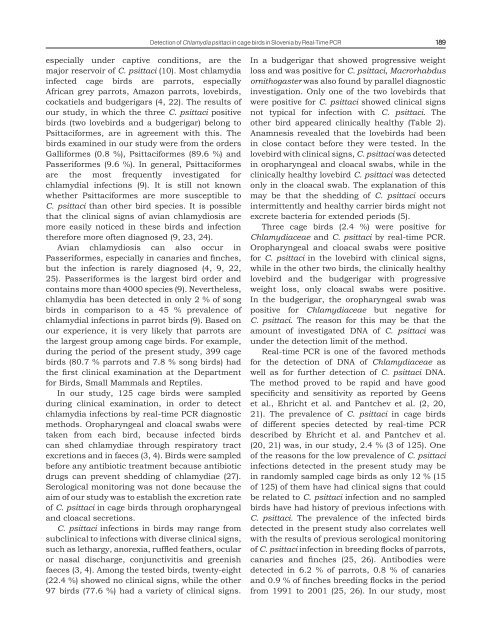SLOVENIAN VETERINARY RESEARCH
SLOVENIAN VETERINARY RESEARCH
SLOVENIAN VETERINARY RESEARCH
Create successful ePaper yourself
Turn your PDF publications into a flip-book with our unique Google optimized e-Paper software.
Detection of Chlamydia psittaci in cage birds in Slovenia by Real-Time PCR 189<br />
especially under captive conditions, are the<br />
major reservoir of C. psittaci (10). Most chlamydia<br />
infected cage birds are parrots, especially<br />
African grey parrots, Amazon parrots, lovebirds,<br />
cockatiels and budgerigars (4, 22). The results of<br />
our study, in which the three C. psittaci positive<br />
birds (two lovebirds and a budgerigar) belong to<br />
Psittaciformes, are in agreement with this. The<br />
birds examined in our study were from the orders<br />
Galliformes (0.8 %), Psittaciformes (89.6 %) and<br />
Passeriformes (9.6 %). In general, Psittaciformes<br />
are the most frequently investigated for<br />
chlamydial infections (9). It is still not known<br />
whether Psittaciformes are more susceptible to<br />
C. psittaci than other bird species. It is possible<br />
that the clinical signs of avian chlamydiosis are<br />
more easily noticed in these birds and infection<br />
therefore more often diagnosed (9, 23, 24).<br />
Avian chlamydiosis can also occur in<br />
Passeriformes, especially in canaries and finches,<br />
but the infection is rarely diagnosed (4, 9, 22,<br />
25). Passeriformes is the largest bird order and<br />
contains more than 4000 species (9). Nevertheless,<br />
chlamydia has been detected in only 2 % of song<br />
birds in comparison to a 45 % prevalence of<br />
chlamydial infections in parrot birds (9). Based on<br />
our experience, it is very likely that parrots are<br />
the largest group among cage birds. For example,<br />
during the period of the present study, 399 cage<br />
birds (80.7 % parrots and 7.8 % song birds) had<br />
the first clinical examination at the Department<br />
for Birds, Small Mammals and Reptiles.<br />
In our study, 125 cage birds were sampled<br />
during clinical examination, in order to detect<br />
chlamydia infections by real-time PCR diagnostic<br />
methods. Oropharyngeal and cloacal swabs were<br />
taken from each bird, because infected birds<br />
can shed chlamydiae through respiratory tract<br />
excretions and in faeces (3, 4). Birds were sampled<br />
before any antibiotic treatment because antibiotic<br />
drugs can prevent shedding of chlamydiae (27).<br />
Serological monitoring was not done because the<br />
aim of our study was to establish the excretion rate<br />
of C. psittaci in cage birds through oropharyngeal<br />
and cloacal secretions.<br />
C. psittaci infections in birds may range from<br />
subclinical to infections with diverse clinical signs,<br />
such as lethargy, anorexia, ruffled feathers, ocular<br />
or nasal discharge, conjunctivitis and greenish<br />
faeces (3, 4). Among the tested birds, twenty-eight<br />
(22.4 %) showed no clinical signs, while the other<br />
97 birds (77.6 %) had a variety of clinical signs.<br />
In a budgerigar that showed progressive weight<br />
loss and was positive for C. psittaci, Macrorhabdus<br />
ornithogaster was also found by parallel diagnostic<br />
investigation. Only one of the two lovebirds that<br />
were positive for C. psittaci showed clinical signs<br />
not typical for infection with C. psittaci. The<br />
other bird appeared clinically healthy (Table 2).<br />
Anamnesis revealed that the lovebirds had been<br />
in close contact before they were tested. In the<br />
lovebird with clinical signs, C. psittaci was detected<br />
in oropharyngeal and cloacal swabs, while in the<br />
clinically healthy lovebird C. psittaci was detected<br />
only in the cloacal swab. The explanation of this<br />
may be that the shedding of C. psittaci occurs<br />
intermittently and healthy carrier birds might not<br />
excrete bacteria for extended periods (5).<br />
Three cage birds (2.4 %) were positive for<br />
Chlamydiaceae and C. psittaci by real-time PCR.<br />
Oropharyngeal and cloacal swabs were positive<br />
for C. psittaci in the lovebird with clinical signs,<br />
while in the other two birds, the clinically healthy<br />
lovebird and the budgerigar with progressive<br />
weight loss, only cloacal swabs were positive.<br />
In the budgerigar, the oropharyngeal swab was<br />
positive for Chlamydiaceae but negative for<br />
C. psittaci. The reason for this may be that the<br />
amount of investigated DNA of C. psittaci was<br />
under the detection limit of the method.<br />
Real-time PCR is one of the favored methods<br />
for the detection of DNA of Chlamydiaceae as<br />
well as for further detection of C. psittaci DNA.<br />
The method proved to be rapid and have good<br />
specificity and sensitivity as reported by Geens<br />
et al., Ehricht et al. and Pantchev et al. (2, 20,<br />
21). The prevalence of C. psittaci in cage birds<br />
of different species detected by real-time PCR<br />
described by Ehricht et al. and Pantchev et al.<br />
(20, 21) was, in our study, 2.4 % (3 of 125). One<br />
of the reasons for the low prevalence of C. psittaci<br />
infections detected in the present study may be<br />
in randomly sampled cage birds as only 12 % (15<br />
of 125) of them have had clinical signs that could<br />
be related to C. psittaci infection and no sampled<br />
birds have had history of previous infections with<br />
C. psittaci. The prevalence of the infected birds<br />
detected in the present study also correlates well<br />
with the results of previous serological monitoring<br />
of C. psittaci infection in breeding flocks of parrots,<br />
canaries and finches (25, 26). Antibodies were<br />
detected in 6.2 % of parrots, 0.8 % of canaries<br />
and 0.9 % of finches breeding flocks in the period<br />
from 1991 to 2001 (25, 26). In our study, most

















